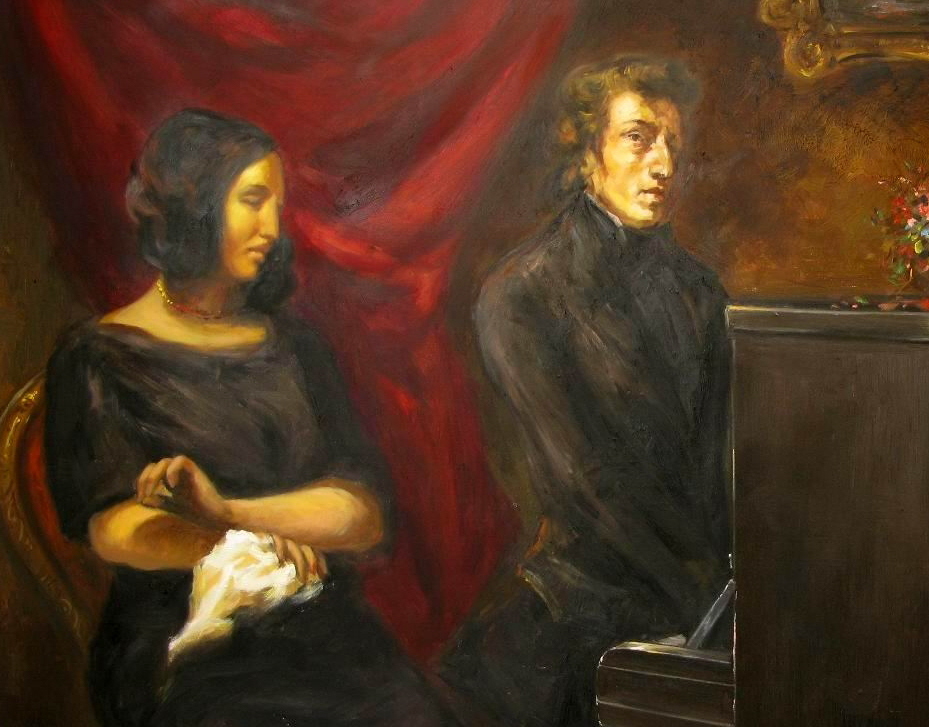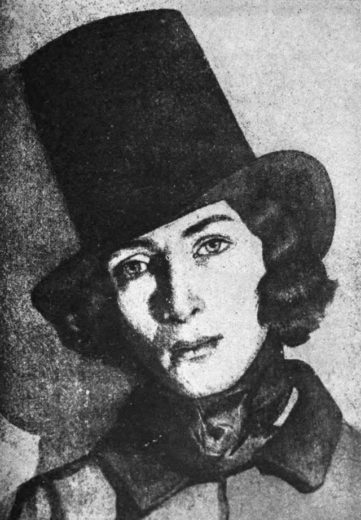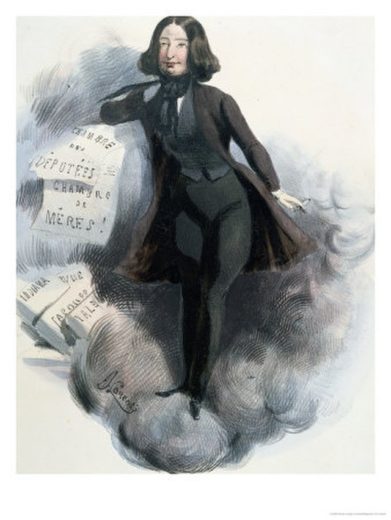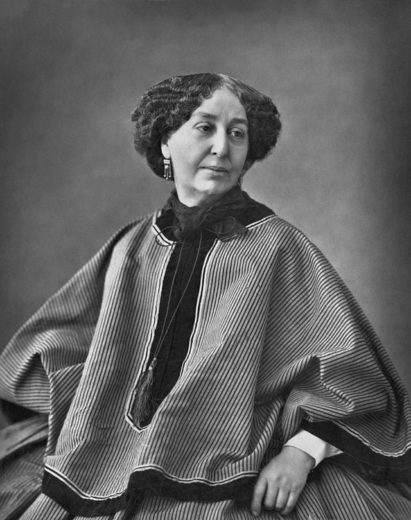
06 Mar Frédéric Chopin and George Sand
Based in part on a Shady Ladies lecture by Edith de Beauville and historian Professor Andrew Lear
George Sand (born Amantine Lucile Aurore Dupin-1804-1876), was one of the most popular writers of her era, respected and befriended by peers Honoré de Balzac, Victor Hugo, Gustave Flaubert, Ivan Turgenev, and Alfred de Musset (with whom she had an affair prior to Frédéric Chopin). Sand lived with extraordinary personal and professional freedom at a time women were bound to their homes and husbands by both society and Napoleonic law.

Portrait of George Sand en costume mascilun (Public Domain)
Aurore’s father died when she was four. Her mother, apparently mentally unbalanced, turned the child over to a grandmother who raised her. In order to escape being placed in a convent, at 18 she married Francois Casimir Dudevant and would bear him two children, Solange and Maurice. The marriage was a disaster, her husband an unfaithful bully.
A year later her grandmother died. In France at the time, one had to be 21 to achieve legal adulthood, but the girl managed to keep both house and inheritance without interference. Monsieur Dudevant lost no time in spending her money. As divorce had been outlawed, Aurore picked up and moved to Paris on her newfound funds, arranging six months with and without custody of the children. Both these exertions of women’s rights were unheard of. Four years later, she would be the first woman in France to achieve legal separation.

Caricature George Sand 1848 (Axagore; Creative Commons Attribution Share Alike)
Restrictions on women were nonetheless omnipresent. In order to move freely (and, she said, for both convenience and protection), Aurore began to dress as a man, a choice outlawed by police unless one was riding or had a doctor’s note. (Consequences of ignoring the law, however, were few and far between.) Victor Hugo commented, “George Sand cannot determine whether she is male or female. I entertain a high regard for all my colleagues, but it is not my place to decide whether she is my sister or my brother.” She also scandalously smoked in public.
Aurore’s first book Rose et Blanche was a collaboration with writer Jules Sandeau (another affair). Its author was listed as “Jules Sand.” The second volume, Indiana, written alone, came out under the nom de plume George Sand. It centers on a young married noblewoman who suffers sequential illness presumably due to lack of passion. Seduction, adultery, life on an island (shades of things to come) and a suicide pact which is thwarted by love make this a perfect romance novel. Women were drawn not only to that aspect, but also its spirited female independence. Her reputation was made.
A series of affairs ran tandem with prolific writing. Sand’s last known relationship was with her son’s best friend 15 years her junior. It lasted 15 years until her death. She died at 72 and is buried behind the chapel at Nohant.

George Sand by Nadar 1864 (Public Domain)
1836, the first of several compendia was published in 24 volumes. This included literary criticism, political texts (She was a member of the provisional government of 1848 and wrote about the Paris Commune of 1871) and autobiographical pieces Histoire de ma vie (1855), Elle et Lui (1859, about her affair with Musset), and Un Hiver a Marjorque (about her life in Majorca with Chopin). In 1880, her children sold the rights to her literary estate for 25,000 Francs. Still, she may be better known for her lifestyle.
Born in Warsaw, Poland, Frédéric François Chopin (1810-1849) began playing piano at age six. A year later, running just behind Mozart’s year-old accomplishment, he wrote and performed his first compositions, the polonaises in G minor and B flat major. His piano teacher saw to it the prodigy attended music school and at a young age Chopin began giving concerts.
At 20, as his country erupted in war, he moved to Paris.The pianist/composer would offer only 30 public performances in his life. Those privileged to hear him live attended private salons. Income was garnered by giving piano lessons and selling compositions. Otherwise affianced for a single year (history suggests the two were never lovers), the sickly Chopin (like his sister he would die of tuberculosis) is not associated with another woman besides George Sand.
When Chopin met Sand, they were both respectively staying at the house of mutual friend, Franz Liszt. According to de Belleville, the author was in her usual male attire. “What an unattractive person la Sand is. Is she really a woman?” Chopin commented. (Jim Samson on Chopin – Oxford University Press) The musician was conservative and a snob. The writer, in turn, initially found her incipient lover frail and rather feminine. A year later, setting her cap for the younger man (all her lovers were younger), Sand wore the finery of her sex and seduced him.

Photo of Frédéric Chopin 1847 (Public Domain)
She was apparently surprised at his effect on her. It’s a testament to Sand’s devotion to the man and his art that she financially supported and nursed the increasingly ill Chopin for nine years, long after they stopped having sex. Madame was still married. In order to escape prying eyes, she took Chopin to Majorca (with her children) even importing a superb Pleyel piano.
Their ill-timed, under researched stay was doomed. It was winter. Living conditions were harsh exacerbating instead of helping Chopin’s illness. Catholic locals banded together against the unmarried couple (who didn’t attend church) and overcharged for everything. Sand’s funds ran thin. Chopin coughed up blood. They began to fight. (The couple couldn’t leave because sailing was dangerous during the season.) Despite all this, under her care, 24 preludes were composed.

Finally able to travel, the two went to Barcelona, Marseilles and finally Sand’s home in France, Nohant. The music room was lined in cork so creativity wouldn’t be hampered by sound. Sand now called Chopin her “third child.” She published the novel Lucrezia Floriani, whose main characters – a rich actress and a prince in weak health – could be stand-ins for the couple.
At this point, her daughter Solange married a man De Belleville describes as mercenary. George had a falling out with her while Chopin evidently took the girl’s side. It tipped the balance and the composer left. He made his last appearance at London’s Guildhall in a benefit for Polish refugees and died a year later at age 39. Frédéric Chopin is buried in Paris’s famous Père-Lachaise Cemetery. Over 230 works of music survive.
Opening: George Sand and Frederic Chopin by Eugene Delacroix- (Public Domain)
Films: Impromptu, George Sand’s meeting with Chopin- Prime video
Children of the Century, a film about George Sand and Alfred de Musset
All taken with a grain of salt
Learn about the fascinating women of the past—shady ladies, nasty women, fashion icons—in fun and revealing tours of the world’s great cities and museums
Coming UP: Saturday March 5: The Gender Rebel Woman Painter of mid-19th Century New York, with Rena Tobey
Renoir’s Women with Edith Belleville (March 12) and Scandals and Secrets of Britain’s Stately Homes with Professor Andrew Lear (March 19)



